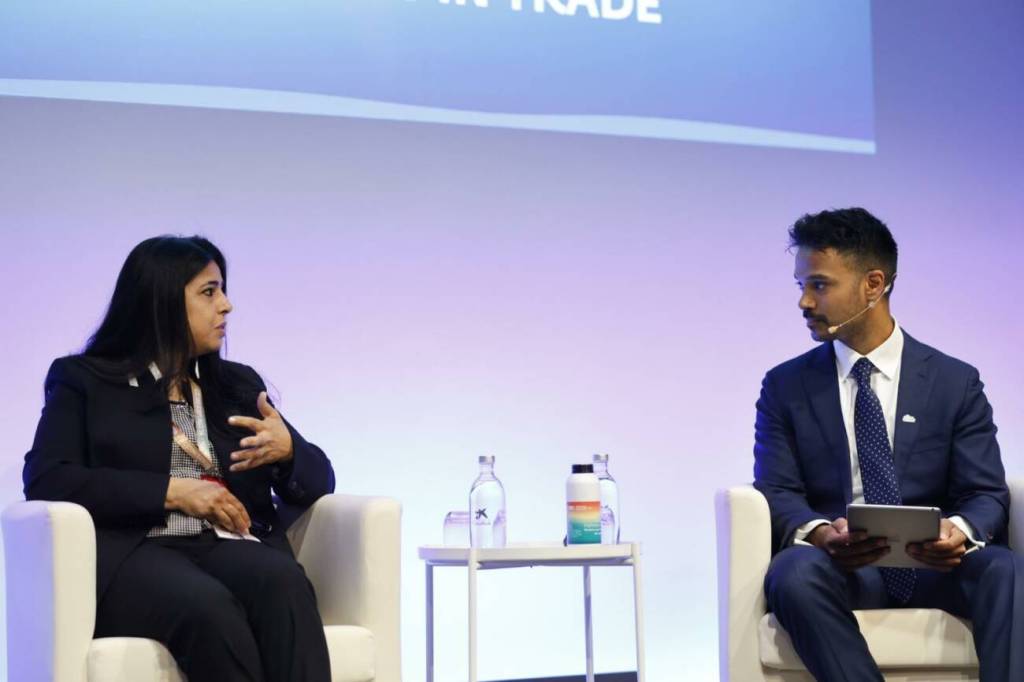Estimated reading time: 7 minutes
Supply chain finance (SCF) has always been critical to global trade, in fact, there are examples of ancient versions of bills of exchange carved into clay tablets in Mesopotamia in 3000 BC.
But the industry has yet again increasingly gained attention over the past few years.
The COVID-19 pandemic, coupled with rising geopolitical tensions and economic volatility, has reshaped the SCF landscape, prompting rapid adaptation and innovation.
At the International Finance Corporation’s (IFC) Global Trade Partners Meeting in Barcelona, Trade Finance Global’s (TFG) Deepesh Patel moderated the panel discussion “Nearshoring and Friendshoring: Navigating the New Waves of Supply Chain Finance” with:
- Ángel Bustos, Managing Director, Global Head, Supply Chain Finance at Santander CIB;
- Parvaiz Dalal, Global Head, Trade Payables at Citigroup;
- Sergio Rodriguez, Europe Head, Products and Propositions – Trade Finance at HSBC;
- Priyamvada Singh, Managing Director and General Manager, Global Head, Supply Chain Finance at SMBC
Digitalisation and automation
The COVID-19 pandemic has acted as a catalyst for digital change in many industries, and supply chain finance is no exception.
The urgency to update manual, paper-heavy processes as the pandemic closed offices around the world drove the adoption of digital tools and automated processes, transforming SCF operations.

Digital signatures, for instance, have replaced the cumbersome process of collecting physical signatures in several jurisdictions, allowing transactions to be completed securely online.
Dalal said, “We now have 58 locations globally where we can take a client’s DocuSign or digital signature and with the enforceability of opinions backing that, we can go to the court of law and call against that document.”
Machine reading tools have further streamlined SCF operations. In North America, the process of filing Uniform Commercial Code (UCC) documents, which previously required extensive legal review and weeks of waiting, has been reduced to a few minutes through automation that can analyse and process documents.
The pandemic also highlighted the necessity of resilience and adaptability in supply chains, prompting many companies to reconfigure their sourcing strategies and move production closer to their markets to mitigate disruptions.
This reconfiguration has been supported by digital SCF platforms that offer real-time services like currency conversion and self-origination for clients. These platforms, designed with microservices architecture, provide the flexibility needed to cater to diverse client needs and integrate with existing systems.
By simplifying access to finance and reducing bureaucratic hurdles, digital tools are helping to democratise SCF, enabling more players, especially small and medium enterprises (SMEs) and those in emerging markets, to participate in and benefit from global trade.
Challenges and opportunities in emerging markets
Emerging markets hold the key to addressing the trade finance gap, which has widened from $1.7 trillion to $2.5 trillion according to the latest figures from the Asian Development Bank’s research in 2023.
These markets, characterised by rapid economic growth and dynamic conditions, are crucial in bridging the financing divide that affects many SMEs in global supply chains, however, the journey is not always easy.
One of the primary hurdles is the regulatory environment. Often, the necessary laws and frameworks to facilitate SCF are either underdeveloped or non-existent, creating significant barriers.
Additionally, even when there are existing regulations, standardisation is not where it needs to be.
Bustos said, “It is very difficult to create global standards for regulations and procedures. The reality that we have in Europe has nothing to do with the reality that we have in Latin America, which is not the same as the reality that we find in Asia.”

Singh said, “There’s a lot of work that still has to be done in emerging markets around laws protecting title and assignment of a receivable. It’s critical to enable banks to offer post-shipment confirmed invoice discounting at scale. Further, this classic payables finance structure is possible only at the very end of the trade cycle for suppliers, while their needs are for financing all along the value chain, not just the confirmed invoice discounting. This is where partnerships with local banks and multilaterals could be useful. They would allow suppliers to access financing earlier in the value chain, which could really make an impact when coupled with confirmed payables finance.”
Addressing these regulatory gaps requires concerted efforts from governments, international organisations, and public-private partnerships, which have emerged as a powerful tool to overcome these challenges.
Another innovative strategy being deployed is deep-tier supply chain finance.
In contrast to traditional SCF, which typically only benefits the first-tier suppliers that are directly linked to large and creditworthy buyers, deep-tier SCF goes deeper down the chain where smaller suppliers often struggle to access financing.
Rodriguez said, “We need to consider that a material portion of the trade finance gap is in the deeper levels of the supply chain, away from those top-tier suppliers.”
In regions like China, regulatory frameworks have evolved to support deep-tier SCF, allowing financing to permeate several layers of the supply chain. This model facilitates financing for even the smallest suppliers by enabling the receivables from first-tier suppliers to be split and transferred digitally, reaching those most in need.

By ensuring that even the smallest players in the supply chain have access to necessary financing, emerging markets are enhancing their economic resilience and contributing to the stability and efficiency of global trade networks, something that is more pressing amid rising geopolitical tensions.
Geopolitical and economic impact on supply chains
Global supply chains have always been susceptible to macroeconomic volatility, however, escalating geopolitical tensions have amplified these challenges, disrupting traditional supply routes and compelling companies to rethink their resilience strategies.
The pandemic exposed the fragility of supply chains that spanned multiple continents and relied heavily on distant manufacturing hubs. As shipping routes were constricted and the physical flow of goods was hampered, businesses realised that the existing models of globalisation, which often prioritised cost efficiency over resilience, were no longer sustainable.
Geopolitical tensions have further underscored the need for such strategic shifts. For instance, the trade war between the United States and China prompted companies to diversify their supply chains to mitigate the risks associated with political instability.
Singh said, “Mexico is now the USA’s largest trade partner, overtaking China. However, if you look at the amount of investment in Mexico by China, it tells a different story.”

This shift is not merely about relocating production but also about forging stronger trade partnerships with politically stable and economically reliable countries—an approach referred to as friendshoring. By establishing supply chains within allied or friendly nations, businesses can navigate geopolitical uncertainties with greater confidence.
The move towards regional centres of sourcing and sales aims to create more localised and resilient supply networks. For instance, a significant portion of fashion executives are now considering moving manufacturing closer to their primary sales markets in the United States and Europe.
This trend highlights a broader reconfiguration, with the focus shifting from cost optimisation to supply chain robustness and reliability.
By bringing production closer to home and aligning with politically and economically stable partners, companies are better equipped to withstand the uncertainties of the modern world, ensuring a steady and reliable flow of goods in an increasingly unpredictable environment.





























